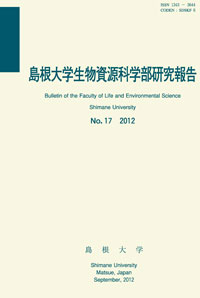島根大学生物資源科学部
ISSN:2435-0885(オンライン)
ISSN:1343-3644(冊子体)
なお、冊子体の刊行は23巻まで
ISSN:1343-3644(冊子体)
なお、冊子体の刊行は23巻まで

ダウンロード数 : ? 件
この文献の参照には次のURLをご利用ください : https://ir.lib.shimane-u.ac.jp/4389
島根大学生物資源科学部研究報告 6
2001-12-20 発行
Quantitative Relation of Spikelet Degeneration with Available Carbohydrate in the Mid-Reproductive Stage
ファイル
内容記述(抄録等)
A considerable percentage of spikelets degenerates in the mid-reproductive stage. To quantify this percentage, shading and thinning treatments were carried out to change the available carbohydrate in plants. Dry matter production and the content of non-structural carbohydrate(NSC)were changed by three shading intensities and one thinning treatment of alternate rows during the mid-reproductive stage. The numbers of differentiated and degenerated spikelets were counted at heading. Shading increased the spikelet degeneration percentage and thinning decreased it by changing shoot dry matter production and stem NSC content. Spikelet degeneration percentage was negatively correlated with both the dry matter production per differentiated spikelet and the NSC amount per differentiated spikelet. We concluded that available carbohydrate per differentiated spikelet determines the number of degenerated spikelets through spikelet competition. Competition for assimilates among spikelets implies that available carbohydrate partitioning would not be optimal for spikelet production and that a part of the available carbohydrate would be used wastefully for degenerated spikelets.
About This Article
Other Article
PP. 23 - 29
